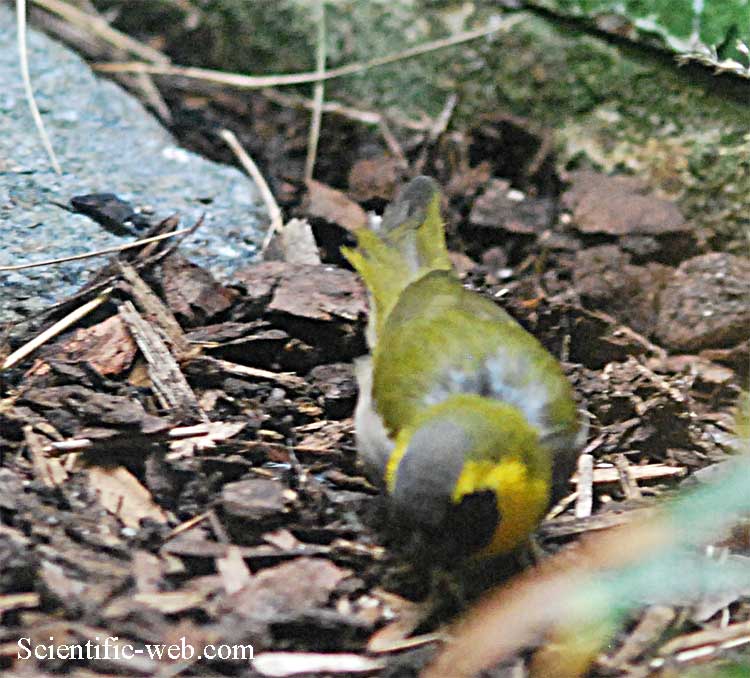
Phonipara canora, Photo: Michael Lahanas
Superregnum: Eukaryota
Regnum: Animalia
Subregnum: Eumetazoa
Cladus: Bilateria
Cladus: Nephrozoa
Superphylum: Deuterostomia
Phylum: Chordata
Subphylum: Vertebrata
Infraphylum: Gnathostomata
Megaclassis: Osteichthyes
Superclassis: Sarcopterygii
Superclassis: Tetrapoda
Cladus: Reptiliomorpha
Cladus: Amniota
Classis: Reptilia
Cladus: Eureptilia
Cladus: Romeriida
Subclassis: Diapsida
Cladus: Sauria
Infraclassis: Archosauromorpha
Cladus: Crurotarsi
Divisio: Archosauria
Cladus: Avemetatarsalia
Cladus: Ornithodira
Subtaxon: Dinosauromorpha
Cladus: Dinosauriformes
Cladus: Dracohors
Cladus: Dinosauria
Ordo: Saurischia
Cladus: Eusaurischia
Cladus: Theropoda
Cladus: Neotheropoda
Cladus: Averostra
Cladus: Tetanurae
Cladus: Avetheropoda
Cladus: Coelurosauria
Cladus: Tyrannoraptora
Cladus: Maniraptoromorpha
Cladus: Maniraptoriformes
Cladus: Maniraptora
Cladus: Pennaraptora
Cladus: Paraves
Cladus: Eumaniraptora
Cladus: Avialae
Infraclassis: Aves
Cladus: Euavialae
Cladus: Avebrevicauda
Cladus: Pygostylia
Cladus: Ornithothoraces
Cladus: Euornithes
Cladus: Ornithuromorpha
Cladus: Ornithurae
Cladus: Carinatae
Parvclassis: Neornithes
Cohors: Neognathae
Cladus: Neoaves
Cladus: Telluraves
Cladus: Australaves
Ordo: Passeriformes
Subordo: Passeri
Infraordo: Passerida
Superfamilia: Passeroidea
Familia: Thraupidae
Genus: Phonipara
Species: Phonipara canora
Name
Phonipara canora (Gmelin, 1789)
Type locality: Nova Hispania, error = Cuba
Synonyms
Loxia canora (protonym)
Loxigilla canora (Gmelin, 1789)
Euetheia canora (Gmelin, 1789)
Tiaris canora (Gmelin, 1789)
Tiaris canorus (Gmelin, 1789)
References
Primary references
Gmelin, J.F. 1789. Caroli a Linné systema naturae per regna tria naturae, secundum classes, ordines, genera, species, cum characteribus, differentiis, synonymis, locis. Tomus I, Pars II. Editio decima tertia, aucta, reformata. - pp. 501–1032. Lipsiae. (Beer). DOI: 10.5962/bhl.title.545 Original description p. 858 BHL Reference page.
Additional references
Burns, K.J., Shultz, A.J., Title, P.O., Mason N.A., Barker, F.K., Klicka, J., Lanyon, S.M. & Lovette, I.J. 2014. Phylogenetics and diversification of tanagers (Passeriformes: Thraupidae), the largest radiation of Neotropical songbirds. Molecular Phylogenetics and Evolution 75:41–77. DOI: 10.1016/j.ympev.2014.02.006 Full article (PDF) Open accessReference page.
Barker, F.K., Burns, K.J., Klicka, J., Lanyon, S.M. & Lovette, I.J. 2015. New insights into New World biogeography: An integrated view from the phylogeny of blackbirds, cardinals, sparrows, tanagers, warblers, and allies. The Auk 132(2): 333-348. DOI: 10.1642/AUK-14-110.1 Open accessReference page.
Burns, K.J., Unitt, P. & Mason, N.A. 2016. A genus-level classification of the family Thraupidae (Class Aves: Order Passeriformes). Zootaxa 4088(3): 329–354. DOI: 10.11646/zootaxa.4088.3.2 Paywall.Reference page.
Vernacular names
English: Cuban Grassquit
español: Semillero canoro
The Cuban grassquit (Phonipara canora) is a small bird in the tanager family Thraupidae. It is endemic to Cuba.
Its natural habitats are subtropical or tropical moist lowland forest, subtropical or tropical moist montane forest, subtropical or tropical dry shrubland, and heavily degraded former forest.
Taxonomy
The Cuban grassquit was formally described in 1789 by the German naturalist Johann Friedrich Gmelin under the binomial name Loxia canora.[2] He based his description on the "Brown Cheeked Grosbeak" that had been described by Peter Brown in 1776. Brown's illustration was from a live bird belonging to Marmaduke Tunstall which Brown mistakenly believed had come from Mexico. It only occurs in Cuba.[3][4] This species was formerly placed in the genus Tiaris,[4] but a molecular phylogenetic study published in 2014 found that Tiaris was polyphyletic.[5] In the resulting reorganization, the Cuban grassquit was moved to the resurrected genus Phonipara that had been introduced in 1850 by the French naturalist Charles Lucien Bonaparte.[6][7][8] The genus name combines the Ancient Greek phōnēs meaning "vocal" with the Latin parus meaning "tit". The specific epithet conora is from Latin canorus meaning "melodious".[9] The Cuban grassquit is monotypic: no subspecies are recognised.[8]
Although traditionally placed with the buntings and New World sparrows in the family Emberizidae,[4] molecular genetic studies have shown that the Cuban grassquit is a member of the subfamily Coerebinae within the tanager family Thraupidae.[7]
References
BirdLife International (2018). "Phonipara canora". IUCN Red List of Threatened Species. 2018: e.T22723595A131889418. doi:10.2305/IUCN.UK.2018-2.RLTS.T22723595A131889418.en. Retrieved 12 November 2021.
Gmelin, Johann Friedrich (1789). Systema naturae per regna tria naturae : secundum classes, ordines, genera, species, cum characteribus, differentiis, synonymis, locis (in Latin). Vol. 1, Part 2 (13th ed.). Lipsiae [Leipzig]: Georg. Emanuel. Beer. p. 858.
Brown, Peter (1776). Nouvelles illustrations de zoologie : contenant cinquante planches enlumineés d'oiseaux curieux, et qui non etés jamais descrits, et quelques de quadrupedes, de reptiles et d'insectes, avec de courtes descriptions systematiques (in French and English). London: B. White. p. 56, Plate 24 fig. 1.
Paynter, Raymond A. Jr, ed. (1970). Check-List of Birds of the World. Vol. 13. Cambridge, Massachusetts: Museum of Comparative Zoology. p. 155.
Burns, K.J.; Shultz, A.J.; Title, P.O.; Mason, N.A.; Barker, F.K.; Klicka, J.; Lanyon, S.M.; Lovette, I.J. (2014). "Phylogenetics and diversification of tanagers (Passeriformes: Thraupidae), the largest radiation of Neotropical songbirds". Molecular Phylogenetics and Evolution. 75: 41–77. doi:10.1016/j.ympev.2014.02.006. PMID 24583021.
Bonaparte, Charles Lucien (1850). "Zoologie. Sur plusieurs genres nouveaux de Passereaux". Comptes Rendus Hebdomadaires des Séances de l'Académie des Sciences. 31: 423–424 [424].
Burns, K.J.; Unitt, P.; Mason, N.A. (2016). "A genus-level classification of the family Thraupidae (Class Aves: Order Passeriformes)". Zootaxa. 4088 (3): 329–354. doi:10.11646/zootaxa.4088.3.2. PMID 27394344.
Gill, Frank; Donsker, David; Rasmussen, Pamela, eds. (July 2020). "Tanagers and allies". IOC World Bird List Version 10.2. International Ornithologists' Union. Retrieved 14 November 2020.
Jobling, James A. (2010). The Helm Dictionary of Scientific Bird Names. London: Christopher Helm. pp. 89, 304. ISBN 978-1-4081-2501-4.
Retrieved from "http://en.wikipedia.org/"
All text is available under the terms of the GNU Free Documentation License

